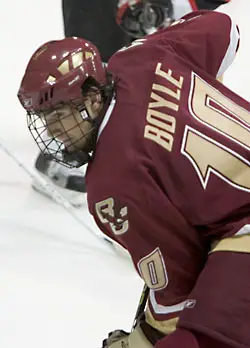When injuries deplete your defensive corps, the instinctive reaction rarely is to take your best scorer and move him to the blue line. When that player is not only your own top scorer but the league’s as well, it’s an even bigger surprise.
And yet that’s what Boston College coach Jerry York decided when defensemen Anthony Aiello and Carl Sneep went down. Brian Boyle, about to earn the second of back-to-back All-Hockey East First Team selections as a forward, became the Eagles’ lead defenseman.
Adding to the magnitude of the switch was its timing. BC had just completed the regular season with a six-game winning streak. If the position change became a disaster, second-guessers might say, “If it ain’t broke, don’t fix it.”

York, however, considered the blue line to be broken and Boyle was the man to fix it.
Boyle recalls, “Coach brought me into his office and said, ‘I really want to use you at D. I think it’ll be good for the team.’
“That’s all he really had to say.”
Boyle, who had played defense on the penalty kill and occasionally at the end of games, hadn’t played the position full-time since trying it for a couple of games in high school.
In the ensuing four playoff games, however, the experiment was a roaring success. BC rolled to a Hockey East championship, winning by lopsided scores — 3-0, 7-1, 6-2 and 5-2 — and Boyle totaled eight points with a plus-minus of +5. As a result, he earned selection as a defenseman to the All-Tournament Team.
“He could be an All-American at both positions,” York says. “He might become an All-American this year as a forward. He probably could have played all year as a defenseman and become an All-American.
“I don’t think I’ve ever had a player that has had that versatility to him. I’ve had a lot of All-Americans, but none that could play forward and then go back and play defense.”
Instead of sacrificing some offense to shore up the blue line, the Eagle scoring has exploded, averaging over five goals a game since Boyle’s move.
“His impact on the game as a defenseman is more dominating than as a forward,” York says. “He just has a real good feel for moving pucks to open people. He’s like a quarterback. You couldn’t really see that [special ability] as a forward, but as a defenseman coming up ice he really shows it.”
Boyle has used veteran defenseman Mike Brennan “as another set of eyes for me” and tried not to out-think himself.
“I’ve just tried to play with what I have,” Boyle says. “If forwards are getting open and yelling, I try to hit them. If I run out of space and time, it’s just a chip off the glass.”
Defensively, he’s tried to make the best use of the wingspan a 6-7 player has at his disposal.
“If I use my reach as well as I can, that’s going to be beneficial for me,” he says. “I’m still trying to get more comfortable gapping up [playing close to an attacker], playing odd-man rushes or one-on-ones. Keeping guys to the outside is what I try to do.
“Just being able to read when they’re going to shoot, I try to get a stick on it. That’s what we’re taught for team defense in D-zone play. Stick on stick and keeping guys away from the net, keeping your body in between the net and the player. Playing center in the D-zone is pretty similar.”
Despite Boyle’s success on the blue line in the first three contests, the championship game against New Hampshire posed special concerns. The Wildcats were far and away the league’s most dangerous offensive team all season and their top two lines were as gifted as they come.
“It certainly was [a concern] last night for me going to bed, thinking about the forwards they have and the amazing quickness and the ability they have to jump on you and turn an odd-man rush for us into an odd-man rush for them,” Boyle says. “They’ve had an unbelievable ability to do that all year. They’re quick, crafty and very creative. We had to give them a lot of respect.”
However, Boyle and the rest of the BC defense, along with a huge helping hand from goaltender Cory Schneider, held UNH scoreless until the third period, by which time the Eagles had built a 4-0 lead. Boyle set up Nathan Gerbe for the fourth goal and then got the empty-netter himself.
As a first-round draft pick of the Los Angeles Kings — one who turned down lucrative offers to return for his senior year — Boyle may be looking at an NHL future on the blue line.
“I think at the next level he’s going to be a defenseman,” York says. “He’s much more dominating as a player.”
As for Boyle, he’s fine either way.
“I couldn’t tell you,” he says. “My college future is on the blue line right now. In the [NCAA] tournament that’s what I’m looking at.
“We flirted with [defense] this summer when I was at development camp with the Kings. It’s an option, I guess, but I’m fine with [either]. It’s going to be a lot of work if they want me back on D, skating-wise, just getting reads down, but it’s going to be a lot of work playing forward because it’s a different game up there. “[But] that’s a lot of thinking that I don’t have time to do, especially in tournament mode.”
The thinking can wait. The NCAA tournament beckons.


